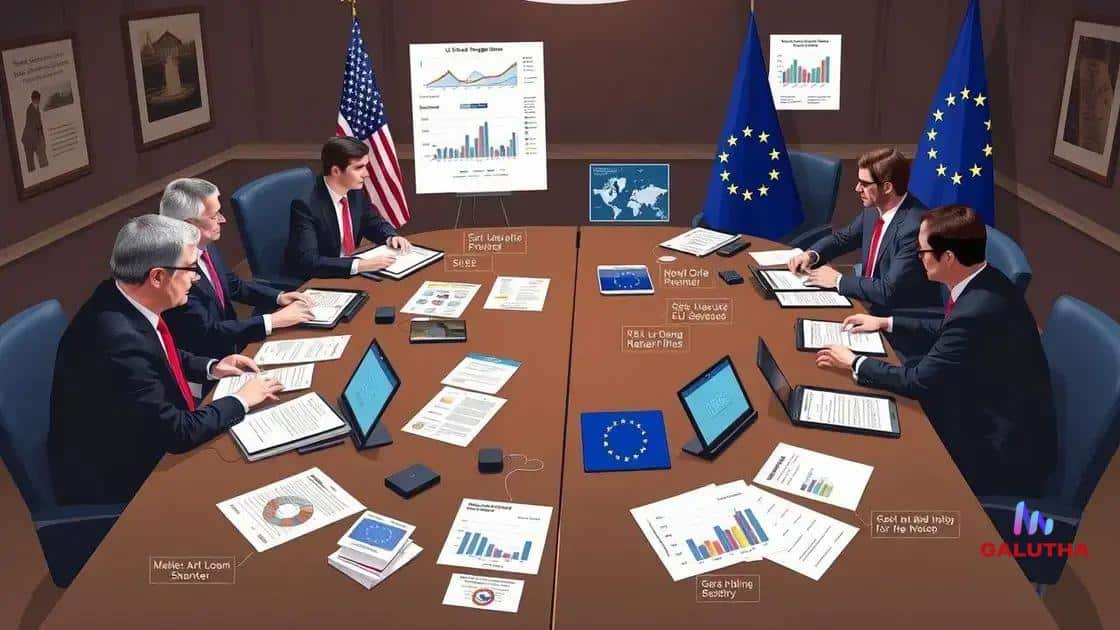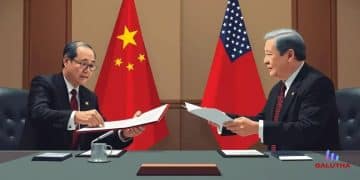U.S.-EU trade agreement negotiations: what to expect
The U.S.-EU trade agreement negotiations focus on reducing tariffs, aligning regulations, enhancing digital trade, and protecting intellectual property, significantly impacting global trade dynamics and economic growth.
U.S.-EU trade agreement negotiations are heating up, and understanding them is essential for anyone tracking economic policies. What could these talks mean for businesses and consumers alike?
Overview of U.S.-EU trade relations
The U.S.-EU trade relations play a pivotal role in shaping the economic landscape between these two regions. With close ties forged over decades, understanding the intricacies of these relationships is essential for grasping global trade dynamics.
Key aspects of these relations include various agreements that facilitate smooth exchanges. This trade often hinges on tariffs, regulations, and mutual agreements that benefit both parties. Let’s delve into some core components that define these relations.
Historical Context
The foundation of U.S.-EU trade relations stretches back many years, establishing a framework that has continually evolved. Initially driven by the need for mutual economic support post-WWII, the relationship has grown to encompass a wide array of sectors.
- Agriculture
- Technology
- Automotive Industry
- Financial Services
This interconnectedness has fostered a competitive environment, allowing both the U.S. and EU to excel in various industries. As global markets change, so too does the nature of their interactions.
Economic Impact
The trade volume between the U.S. and EU is staggering, contributing significantly to both economies. In 2022 alone, the total trade was valued at over $1 trillion, highlighting the importance of this relationship.
Without a doubt, the outcome of trade negotiations directly influences job creation and economic growth. This interdependence not only benefits large conglomerates but also small to medium enterprises that rely on these markets to thrive.
Furthermore, various trade deals and pacts aim to streamline customs processes, lower tariffs, and enhance cooperation. By navigating these complexities, both regions can ensure a mutually prosperous future.
In conclusion, the overview of U.S.-EU trade relations illustrates a dynamic partnership characterized by continuous development and mutual benefit. Properly understanding these relations enables stakeholders to anticipate changes in the global marketplace.
Key topics in current negotiations

In the context of U.S.-EU trade agreement negotiations, several key topics are shaping the discussions. These areas are vital because they affect economic policies, trade relations, and the overall relationship between the two regions.
One of the critical topics is the issue of tariffs. Both the U.S. and EU have varying tariffs that impact numerous industries. Lowering these tariffs could lead to increased trade flows, benefiting both economies.
Regulatory Standards
Another important theme is regulatory alignment. The U.S. and EU have different standards for product safety, environmental regulations, and labor practices. Harmonizing these regulations can reduce barriers and make trade more efficient.
- Food safety regulations
- Environmental protections
- Consumer product standards
- Labor rights and practices
Additionally, digital trade is a hot topic. As technology evolves, creating rules for data flow and cybersecurity is necessary. Both regions recognize the need for a framework that protects consumers while allowing innovation.
Intellectual Property
Intellectual property (IP) rights also play a significant role in the negotiations. Protecting IP fosters innovation and creativity. It ensures that inventors and creators can benefit from their work without fear of infringement.
- Patents and trademarks
- Copyright protections
- Trade secrets
- Enforcement mechanisms
In summary, the key topics in current negotiations highlight the complex nature of U.S.-EU trade relations. Understanding these issues is crucial for predicting outcomes and preparing for potential changes in the commercial landscape.
Impact on global trade dynamics
The impact on global trade dynamics due to U.S.-EU trade agreement negotiations is significant. As these two regions work towards agreements, their actions can create ripple effects around the world.
One key area affected is the balance of trade. When the U.S. and EU come together to reduce tariffs or increase trade opportunities, it leads to changes in trade patterns. Companies in other countries may need to adjust their strategies to remain competitive.
Shifts in Trade Partnerships
As a result of these negotiations, countries outside the U.S. and EU might find themselves looking for new trade partners. When trade barriers between the U.S. and EU decrease, businesses may prefer dealing with each other over other regions. This could lead to a shift in manufacturing and export strategies.
- Emerging markets could rise as new trade partners.
- Dependence on certain imports may decrease.
- Countries may seek to strengthen ties with either the U.S. or EU.
- Global supply chains will need to adapt.
Furthermore, the U.S.-EU negotiations create precedents for other trade deals worldwide. If successful frameworks emerge, they can inspire similar agreements between other nations. This could enhance global cooperation and trade efficiency.
Economic Growth and Innovation
Trade agreements often foster economic growth. With improved trade relations, businesses have greater opportunities to expand into new markets. This can lead to job creation and innovation.
Moreover, the potential for increased competition benefits consumers. As businesses strive to provide better products and services, it often results in lower prices and more choices.
In summary, the impact of the U.S.-EU negotiations on global trade dynamics highlights the interconnected nature of today’s economy. Understanding these dynamics is crucial for businesses and governments alike.
Challenges in reaching an agreement

Reaching an agreement in U.S.-EU trade negotiations involves navigating several challenges. These hurdles are rooted in the differences between the two regions, making consensus hard to achieve.
One major challenge is the varying regulatory standards. Each region has its own rules regarding safety, environmental protection, and labor laws. This divergence can create friction, as both sides work to reconcile their differences.
Political Factors
Politics also play a significant role in the negotiations. Changes in leadership can shift priorities and alter the willingness to compromise. For instance, shifts in party control can impact strategies and negotiating positions.
- The influence of interest groups.
- Public opinion on trade policies.
- Upcoming elections that may affect negotiations.
- International relations affecting negotiations.
Additionally, public sentiment towards trade agreements can create backlash. Many citizens feel that trade deals may threaten jobs or lead to unfair competition. As a result, negotiators must carefully balance domestic concerns against the benefits of international agreements.
Economic Disparities
The economic landscape is another challenge. The U.S. and EU have different economic strengths and vulnerabilities. These differences can complicate negotiations as both parties try to protect their interests.
Small economies within the EU may have concerns that larger economies do not share, leading to unequal impacts of proposed agreements. This disparity in economic power can stall discussions and create distrust.
Moreover, unexpected global events can change the dynamics of negotiations. Economic downturns, pandemics, or geopolitical tensions can all shift priorities and disrupt timelines.
As these challenges unfold, the path to a successful agreement reflects the complex interplay of regulatory, political, and economic factors. Understanding these hurdles is crucial for anyone following U.S.-EU trade agreement negotiations.
Future prospects for U.S.-EU trade
The future prospects for U.S.-EU trade appear promising as both regions continue to explore ways to enhance their economic relationship. Ongoing negotiations hint at a potential for transformative agreements that could reshape trade practices.
One key area for future growth is in technological collaboration. As both the U.S. and EU prioritize innovation, partnerships in technology, especially in areas like artificial intelligence and green energy, can foster new opportunities. Innovation not only drives economic growth but also creates jobs.
Trade Agreements
Future trade agreements may focus on reducing tariffs and creating streamlined regulations that benefit both markets. The aim is to create a more seamless trading environment.
- Elimination or reduction of tariffs on goods.
- Improved regulations to ease market entry.
- Collaboration on environmental standards.
- Enhanced protection of intellectual property rights.
Furthermore, the importance of digital trade is growing. As e-commerce continues to expand, the need for rules governing data flows, privacy, and security becomes essential. Future negotiations may reflect this shift, leading to agreements that benefit online businesses.
Global Influence
The impact of U.S.-EU trade dynamics will also influence global markets. As leaders in trade, their agreements set the tone for other regions. Developing countries may look to the U.S. and EU for guidance, altering traditional trade patterns.
Emerging economies could find new pathways to access the markets of these economic giants. This may encourage growth and development in regions that strengthen ties with the U.S. and EU.
In addition to trade, diplomatic ties will likely deepen further. A strong U.S.-EU partnership can lead to collaboration on global challenges like climate change, health crises, and political stability.
In summary, the future of U.S.-EU trade holds significant potential for innovation, growth, and improved relations, shaping the global economic landscape for years to come.
In conclusion, the future of U.S.-EU trade holds exciting possibilities. As both regions work together, they can create agreements that boost innovation, streamline regulations, and enhance economic stability. By addressing key challenges and exploring new opportunities, the partnership between the U.S. and EU can set the stage for a stronger global economy. Understanding these dynamics will be crucial in adapting to changes that affect businesses and consumers alike.
FAQ – Frequently Asked Questions about U.S.-EU Trade Relations
What are the main areas of focus in U.S.-EU trade negotiations?
The main areas include tariff reductions, regulatory alignment, digital trade rules, and intellectual property protections.
How do U.S.-EU trade agreements impact global markets?
These agreements set standards that can influence trade dynamics worldwide, affecting other countries and their trade practices.
What challenges do negotiators face in reaching agreements?
Key challenges include differing regulations, political factors, public sentiment, and economic disparities between the regions.
What are the future prospects for U.S.-EU trade?
Future prospects look promising with potential growth in technology collaboration, streamlined regulations, and enhanced economic stability through partnerships.





